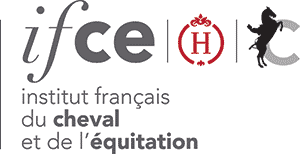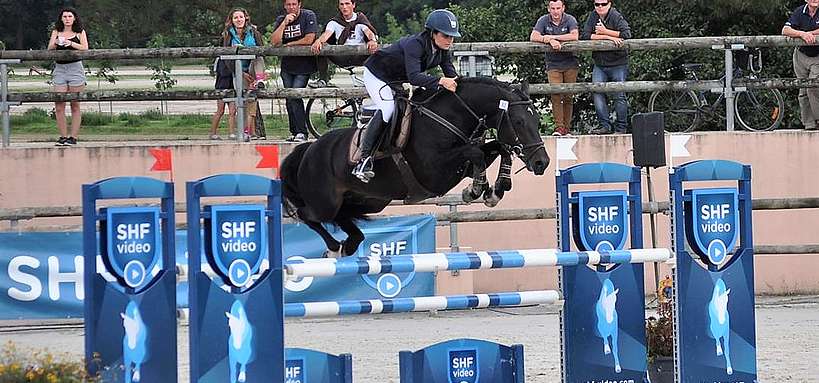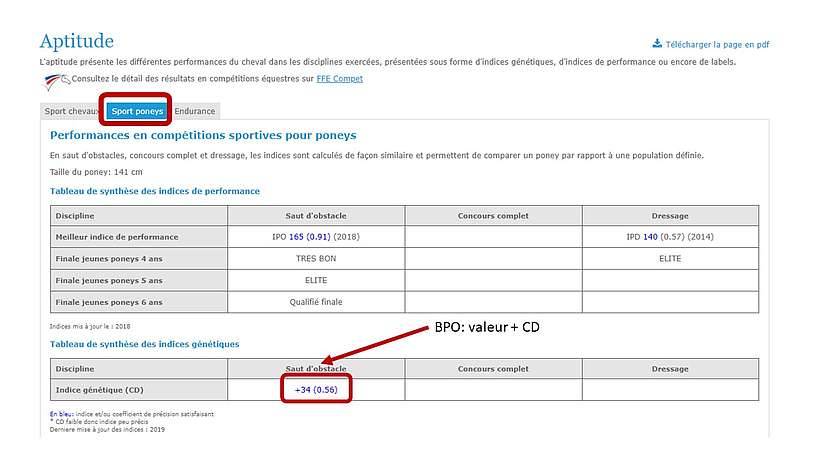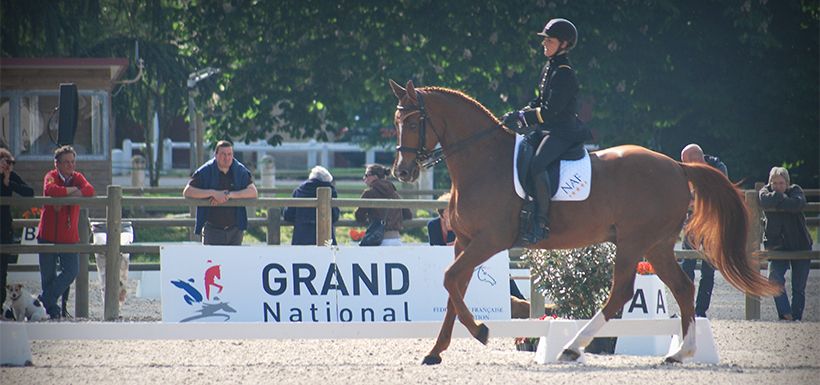

Show-jumping ponies’ genetic index
Two indices are available for ponies. The IPO (performance index) which characterises the sports worth of a pony from his performances in show-jumping. The BPO (genetic index calculated according to the « BLUP » method), gives an indication of the capacity of a reproducer to transmit his qualities to his progeny and descendants. The genetic index for a show-jumping pony (BPO) is an estimation of the actual genetic worth of an animal. It serves to foresee the qualities of the progeny of a reproducer (male or female). Genetic worth cannot however be known with absolute certainty. This is why a coefficient of determination (CD = reliability of an index)) is attributed to a BPO. The value of the CD is situated between 0 and 1 (100 % reliability).


- How is the BPO, genetic index for show-jumping ponies, calculated ?
- Presentation of the BPO and the coefficient of determination (CD)
- A tool to help in breeding selection
How is the BPO, genetic index for show-jumping ponies, calculated ?
A show-jumping pony’s genetic index is based on the subject’s performance index, and those of his related kindred. A quick reminder : a Pony’s performance index (IPO) is measured thanks to two criteria of equal importance :
- Point index : At every competition, points are attributed according to the technical difficulty of the class, and the ranking in the class. This criteria is the sum of all the points from all the classes the pony took part in over a year. This criteria gives the edge to ponies who often participate, even when their performances are variable.
- Ranking index : The synthesis depends on the probability of beating other ponies competed against, when the animal in question is ranked better, and of being beaten when ranked behind. This criteria therefore takes into account the level of the competition encountered. It gives the edge to regularity, as it sanctions counter performances.

Any pony with a registered genealogy has a BPO if at least one parent has a BPO. The data which can then improve the coefficient of determination (CD= BPO accuracy) are listed below :
- Complete genealogy
- Related kin having competed
- Own performances when having taken part in competitions.
Pony competitions are organised according to the size category of the pony. Differences in performance due to size are taken into account and corrected. A category B pony is judged on his capacity to produce good progeny in his size category, he can therefore have a genetic index equal to that of a category D pony, even if his progeny does not jump as high.
A foal’s BPO can therefore be calculated before it is even conceived :
- BPO foal = (BPO sire + BPO dam) / 2
- CD foal = (CD sire + CD dam) / 4
Presentation of the BPO and the coefficient of determination (CD)
Every year indices are recalculated taking into account any new data available from the previous year’s competitions. Because selection is effective, ponies are better than the previous year. The indices are calculated with a « mobile base » for readability and points of reference. Thus the average index for competitive ponies aged between 5 and 7 years old ( reference population) is centered on 0, with the top 2 % possessing an index of +20 or more. A pony is therefore compared to a reference population.

It is common to find ancestors horses in ponies. These horses will therefore have a BPO from their descendants. Depending on the number of offspring a stallion has produced, his CD may be comparable to a pony stallion.
The indices are available on the Ifce website : www.ifce.fr > Section Info chevaux/Aptitude/sport poneys.

An index is interpreted according to its Coefficient of determ ination (CD). The value of the CD depends on the quantity of data available for the calculation of the genetic index, rather than the quality :
- The number of competition performances achieved by the pony : the more affiliated competitions taken part in, the more consolidated the CD
- The number of competition performances achieved by related kin (ascendants, descendants, other related kin) and the closeness of the related kin (progeny has a higher impact than a half- brother)
In practice, the interval over which the CD varies is as follows :
a) From 0,04 to 0,36 if only the ascendants are known (average 0,18) ;
b) From 0,31 to 0,63 if the ascendants and their performances are known (average 0,46)
c) From 0,42 to 0,66 if ascendants, their performances and fewer than 10 progeny are known (average 0,56)
d) Over 0,70 if ascendants, their performances and over 10 progeny are known. The CD will be closer to the maximum value of 1 (average 0,82).

A tool to help in breeding selection
In equestrian sports, when selection is based only on one aptitude (for example show-jumping), it has been demonstrated that selecting the top 2 % of males is enough to obtain significant gain in genetic worth, and therefore in performances. This is why when presenting genetic indices only 2 % of the population is ranked over the +20 threshold.
When looking at selection on the side of the mares, while ensuring renewal of a stable population, the possible selection ratio would be of 50 %. This is why the average index of the population in a selection process is 0, with 50 % being positive, and 50 % being negative.

Know more about our authors
- Translated from french by : Karen DUFFY Translator
- Margot SABBAGH Development engineer IFCE
- Bernard DUMONT SAINT PRIEST Development engineer IFCE
- Harmony CRICHAN Ingénieur de développement Ifce









